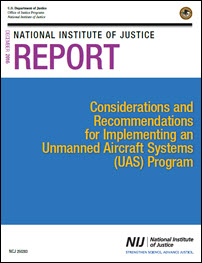How Law Enforcement Can Harness the Benefits of an Unmanned Aircraft Systems (UAS) Program
- December 16, 2016
- Posted by: Drew Jurkofsky
- Category: Industry Updates

Washington, D.C. In Alameda County, California, an Unmanned Aircraft Systems (UAS) program has supported law enforcement in successfully monitoring crime scenes and capturing suspects on the run.
While these devices have been beneficial in assisting law enforcement in a number of ways, they’ve also raised concerns within the community about the possibility of police violating privacy rights through aerial surveillance.
Alameda County isn’t alone in this situation. Law Enforcement agencies around the country are having similar discussions within their communities as they look to take advantage of the benefits of unmanned aerial vehicles while also ensuring the rights of the public are protected.
In a new report, the National Institute of Justice (NIJ) covers a number of emerging issues and concerns on the use of unmanned aircraft systems by state, local, and tribal law enforcement.
“Considerations and Recommendations for Implementing an Unmanned Aircraft Systems Program” is based on an August 2015 convening of public safety stakeholders and aviation experts. The goal of the convening was to produce a blueprint for how law enforcement agencies can use unmanned aircraft systems most effectively, fairly, and transparently.
This NIJ report highlights a number of actions that agencies can take internally and with the community as they implement a policy on unmanned aircraft systems.
According to Mike O’Shea, a senior law enforcement program manager with NIJ, community acceptance is critical to just about every law enforcement initiative out there.
“The transparency of what you’re doing as an agency can make a difference between whether or not the community accepts what you’re doing or doesn’t accept [it],” he said.
“And in the case of unmanned aerial vehicles, one of the biggest challenges for law enforcement is getting public acceptance,” O’Shea added.
With regards to engaging the community, it is recommended that agencies engage the community early on as this strategy is most effective at the beginning of the process of implementing a UAS program. Additionally, agencies are recommended to create a community advisory panel on the implementation of new technologies, such as UAS.
“The public acceptance of technology is crucial to the implementation of unmanned aircraft systems,” O’Shea said.
Recommendations also include that all members of the agency should be briefed on the capabilities and intended use of the technology so that there will be a common message when officials interact with the public.
Promoting the responsible use of unmanned aircraft systems is critical, such that agencies using this technology have sound policies in place governing the collection, use, and retention of data, and to ensure that agencies are transparent in how they are using these systems.
In terms of developing privacy policies, it’s important for an agency to fully understand the complex legal environment in which unmanned aerial vehicles operate. Furthermore, some states and localities have imposed more stringent requirements than federal law on the use of this technology by law enforcement.
Unmanned aircraft systems have the potential to be a useful public safety tool, but the decision of whether and how it should be adopted is one that every law enforcement agency must make for itself, and that decision should be made in coordination with community members. These community decisions should consider privacy, civil rights, and civil liberties concerns.
According to the Bureau of Justice Statistics, only about 350 law enforcement agencies in the U.S. had aviation programs in active use. The number has remained small due to a number of factors, including the substantial cost of starting and maintaining a program, and bureaucratic hurdles needed to approve the use of such technology.
But as more agencies begin to experience the benefits of unmanned aerial vehicles, O’Shea believes the use of this technology will only expand moving forward.
“I think you are going to see the utilization of this technology grow significantly. Not only will the law enforcement use grow, but you’re also going to see fire agencies and emergency management agencies start to utilize UAS technologies in support of their respective missions,” O’Shea said.
As agencies consider the use of this technology, this NIJ report encourages them to remember one specific piece of advice: “The mission should drive the technology; the technology should not drive the mission.”
National Institute of Justice, “How Law Enforcement Can Harness the Benefits of an Unmanned Aircraft Systems Program,” December 16, 2016, from NIJ.gov: https://nij.gov/topics/law-enforcement/operations/aviation/pages/harnass-benefits-of-unmanned-aircraft-systems.aspx
